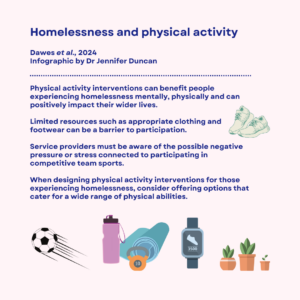This study was recently published in BJSM and summarises the physical activity interventions in those who are experiencing homelessness (1).
Why is this study important?
People experiencing homelessness commonly live with poor health. Physical activity can benefit health and wellbeing more broadly. Some studies have shown benefits for physical activity programmes in this population, but this body of evidence has not previously been pulled together and considered as a whole. Our systematic review has done this, gathering worldwide research that explores a variety of physical activity programmes, specifically targeting people experiencing homelessness. This is important because combining results from individual studies into a single review can generate new insights and findings.
How did the study go about this?
The authors searched a variety of databases for studies published up to 19 October 2022 which evaluated physical activity interventions for people experiencing homelessness. This was a mixed methods review, so we searched for data collected using various approaches. This included, any data which quantitatively measured outcomes such as the physiological and psychological effects of interventions also, qualitatively reported data such as opinions and feelings about physical activity interventions from people who are homeless and other stakeholders. We described numerical results in words, so numerical and non-numerical data could be combined. We rated the quality of the evidence, based on factors such as study methods.
What did the study find?
We found 17 relevant studies which included 516 participants experiencing homelessness (with an age range varying from 16-65 years) and 38 staff working in this area. Seven studies were from the USA, five from the UK, three from Denmark, and two from Australia. Seven physical activity programmes were soccer based, five were group-based outdoor exercise, three were group-based indoor exercise and two were individual interventions, such as being given a pedometer and walking targets.
Thirteen out of the seventeen relevant studies were rated as high or moderate quality. People experiencing homelessness and those working in this area described the benefits of physical activity as having a positive effect on addiction and additional benefits carried into wider life. Some studies showed that measures such as fitness, musculoskeletal health and blood markers improved. There was strongest evidence for the mental health benefits of outdoor based-programmes and physical activity level increases with indoor programmes, where both quantitative findings about mood and qualitative descriptions were reported about these programmes. However, challenges of participating were also noted, particularly in team sports like soccer.
What are the key take-home points?
People experiencing homelessness can benefit from physical activity interventions with a wide range of positive mental and physical benefits with translation of benefits to wider life. However, we must be aware of the possible negative pressures placed on this group when participating in competitive sports such as soccer tournaments. This needs to be handled carefully by tournament organisers and staff, with additional support offered where necessary.
It is important to be aware that limited resources such as appropriate clothing and footwear may be a barrier to participation, so provision of kit to enable participation needs to be considered.
Overall, providers of community based physical activities should consider how to include people who are homeless. Moreover, physical activity interventions targeting people experiencing homelessness should be evaluated, reporting the impact it has on health and wellbeing, to help grow the evidence base in this area.
When designing physical activity interventions for people experiencing homelessness, consider offering options which cater to a wider range of physical abilities. Physical activity interventions can be delivered in isolation or as part of a broader programme with other health promoting components. There may be additional benefits for group-based exercise and out-door exercise.

References:
(1) Dawes J, Rogans-Watson R, Broderick J. ‘You can change your life through sports’-physical activity interventions to improve the health and well-being of adults experiencing homelessness: a mixed-methods systematic review. Br J Sports Med. 2024 Apr 2;58(8):444-458. doi: 10.1136/bjsports-2023-107562. PMID: 38413132; PMCID: PMC11041619.
Authors:
Jo Dawes, Raphael Rogans-Watson and Julie Broderick